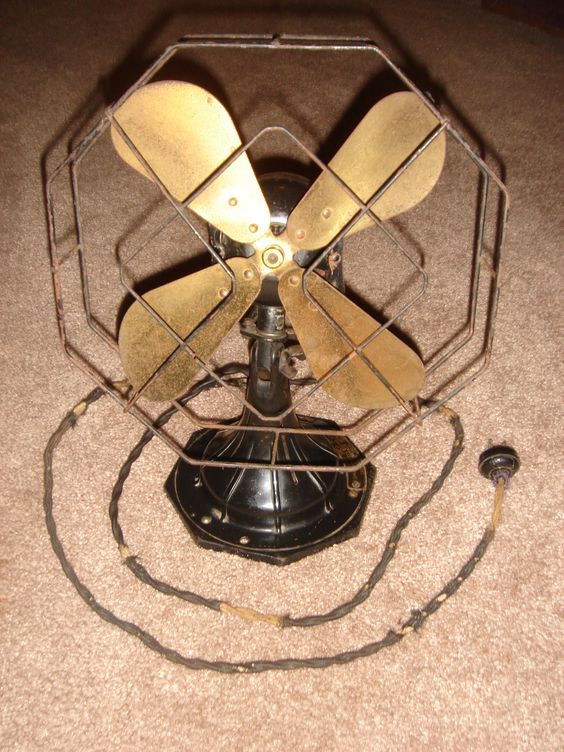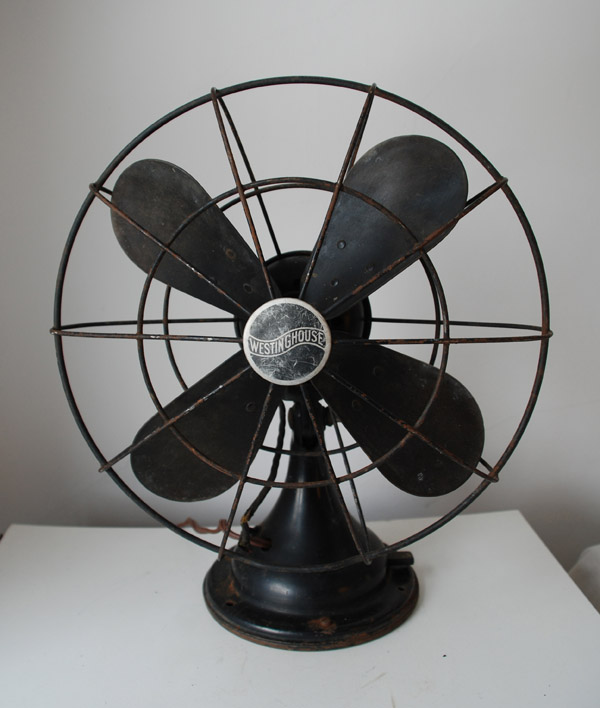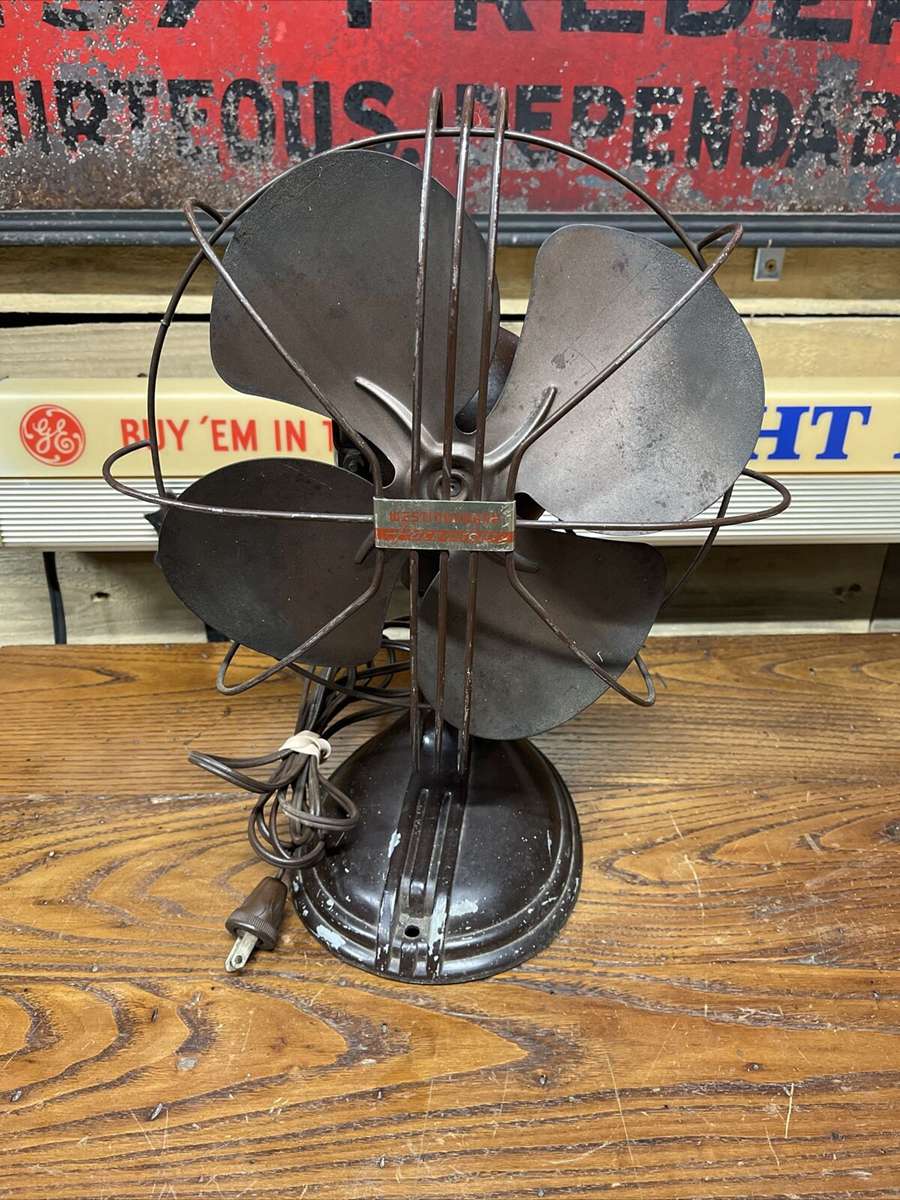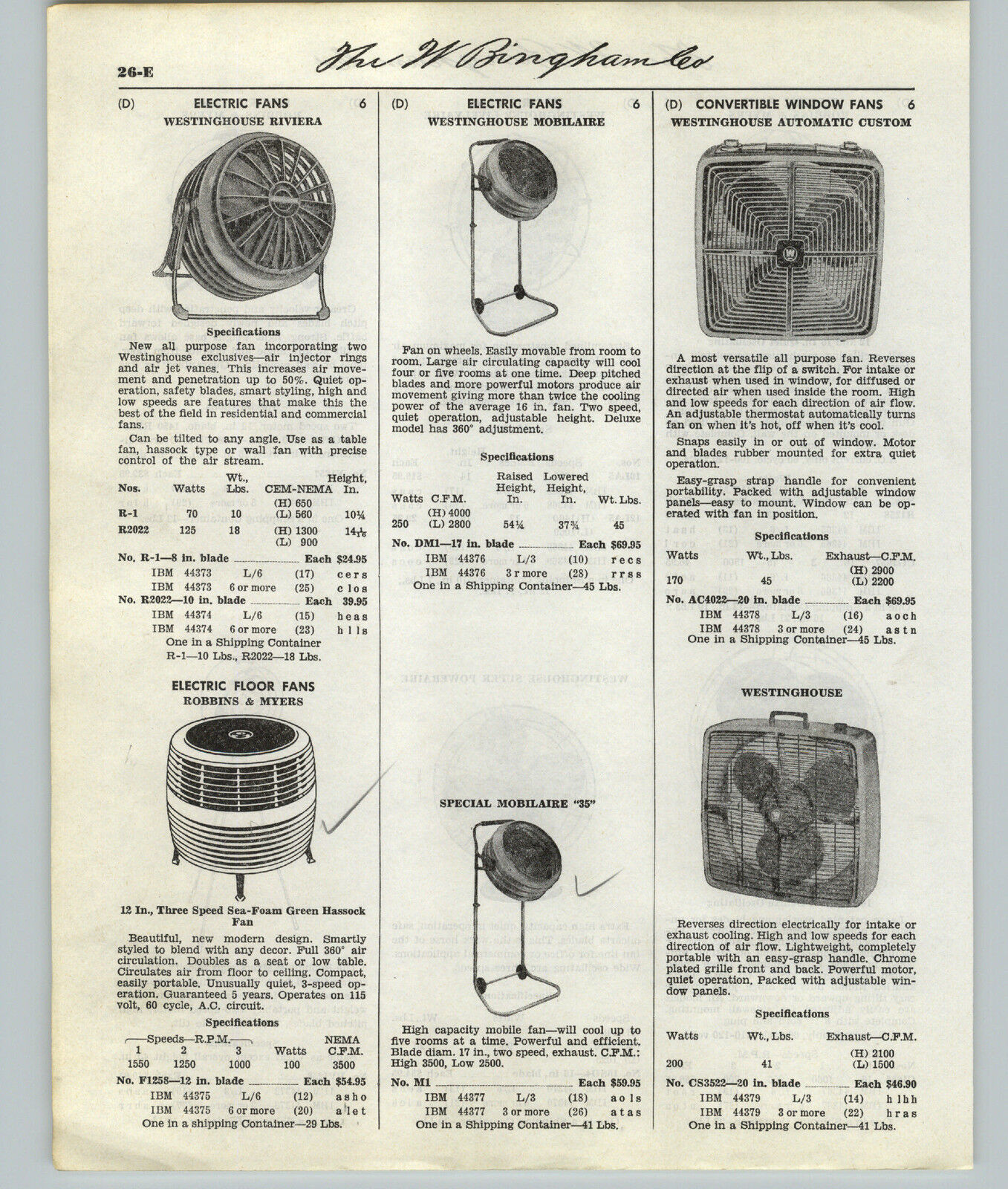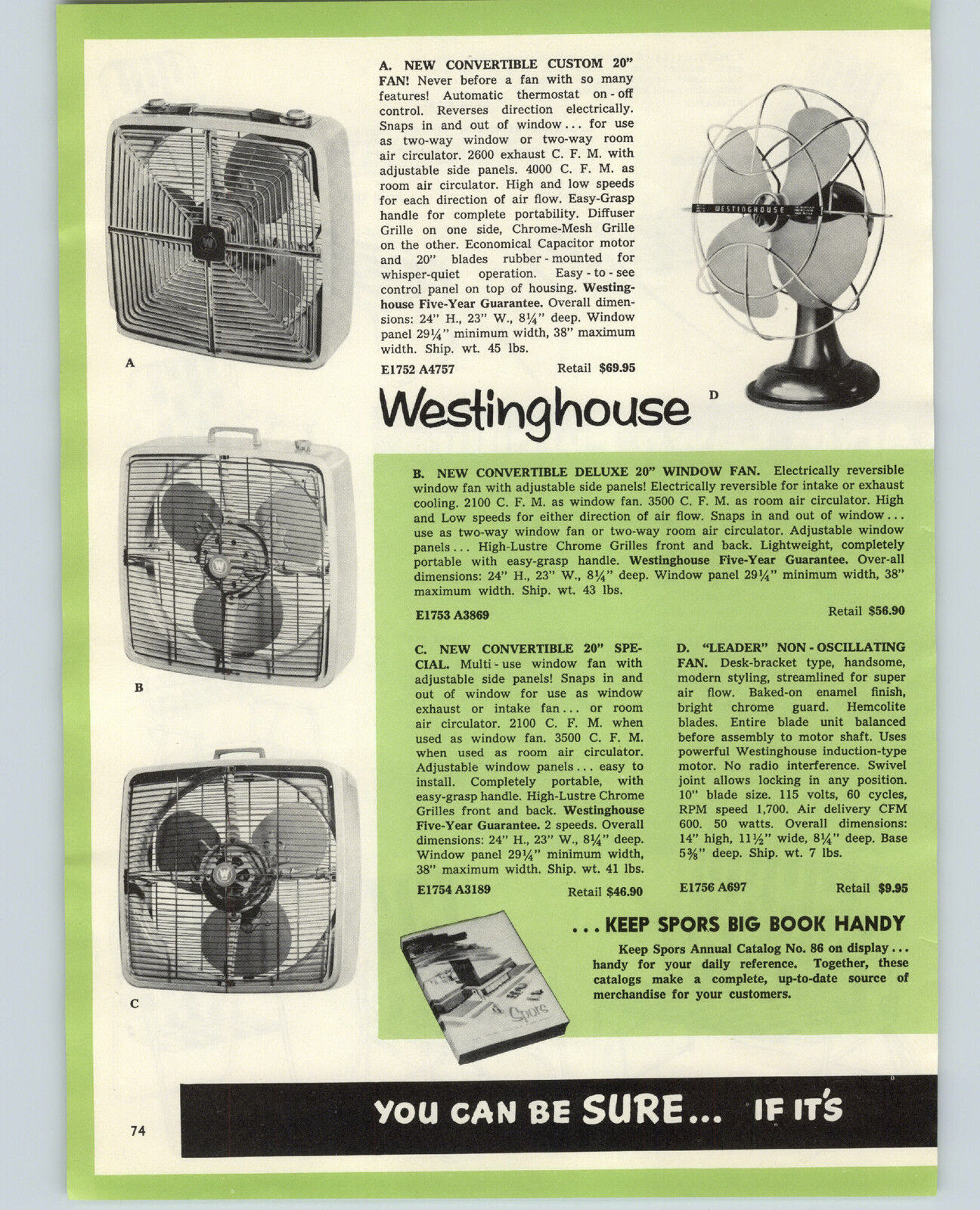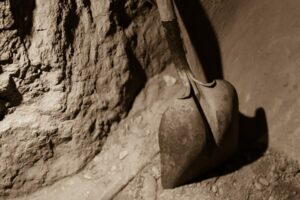Vintage Westinghouse fans are a popular collectible item for their nostalgic charm and enduring functionality. As an enthusiast, understanding how to identify and assess the value of these antique fans will not only enrich your collecting experience but also help you make informed decisions when buying and selling. In this guide, you’ll learn about the different features of vintage Westinghouse fans, from their design and materials to unique series and models.
One of the first aspects you’ll want to examine when identifying a Westinghouse fan is the specific model and date of production. Many Westinghouse fans made during the early 20th century, such as the Pacemaker and Poweraire, came in various sizes and styles, including stationary and oscillating models. Pay close attention to the fan’s motor tag and any numbers or dates in parentheses, as this information can be vital in identifying your fan’s age and rarity.
In addition to identifying the model, evaluating the condition and quality of a vintage Westinghouse fan is crucial in determining its value. Factors such as the originality of the components, the presence or absence of rust, and the functionality of the fan’s motor can all impact the fan’s worth. Understanding how these aspects come together in the value assessment process will help you better appreciate the true value of your vintage Westinghouse fan and ensure that you’re equipped to buy and sell these antique treasures with confidence.
Table of Contents
History of Westinghouse Fans
Westinghouse, a renowned American company, has been an influential player in fan manufacturing since the early 20th century. Throughout the years, they have produced various fan models that are still highly sought after by vintage fan collectors.
In the 1920s, Westinghouse introduced the Whirlwind fan, which became quite popular. These fans run on a single-speed mechanism and feature a left-to-right oscillation function. The typical value of a Whirlwind fan ranges from $70 to $150.
Around 1924, Westinghouse began using a substance called micarta for their fan blades. It was a lightweight and resilient material created by applying a resin on layers of paper or cloth. This innovation set Westinghouse apart from other manufacturers and contributed to their success.
During the 1930s, Westinghouse ventured into new designs for their desk and pedestal fans. Some notable models from this era include:
- Debon-Air Model 46 (1931)
- Master-Aire Model 12-F-3 (1934)
- Pacemaker (1937 to 1946)
The Poweraire was another Westinghouse fan model from the late 1940s to the mid-1950s. It was available in 2-speed variants and initially had a deep-pitched micarta blade.
Towards the end of the 1930s, the Frostaire fan was introduced and had a short production run of one or two years. After that, the Pacemaker took over in 1937, followed by LivelyAire and the Standard in the late 1940s.
As you explore the history of Westinghouse fans, keep in mind that part of their appeal lies in their unique designs and innovative materials. These vintage fans not only represent an important part of the company’s history but also demonstrate the progress of fan technology throughout the years.
Types of Vintage Westinghouse Fans
In this section, you’ll learn about the different types of vintage Westinghouse fans, including Poweraire, LivelyAire, and Oscillating models. These fans have unique features and were produced during specific time periods, making them desirable for collectors.
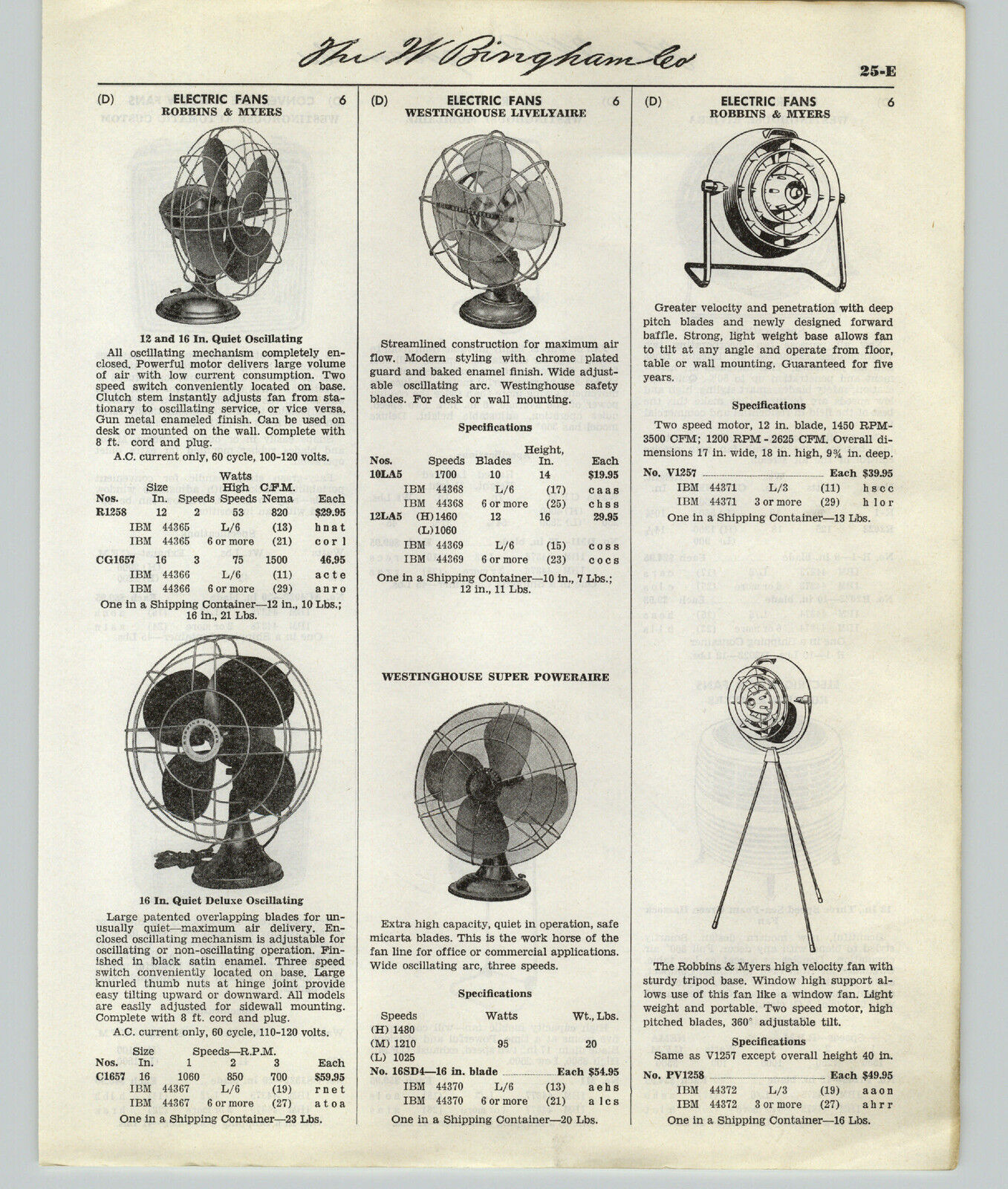
Poweraire
The Westinghouse Poweraire is a vintage fan, produced from the late 1940s to the mid-1950s. This model is known for its two-speed mechanism and is sought after by collectors due to its distinctive design. The original Poweraire featured a deep-pitched Micarta blade, which is a lightweight plastic-type material. However, you might find some with blades from older Westinghouse models, such as those from the late teens to mid-1920s.
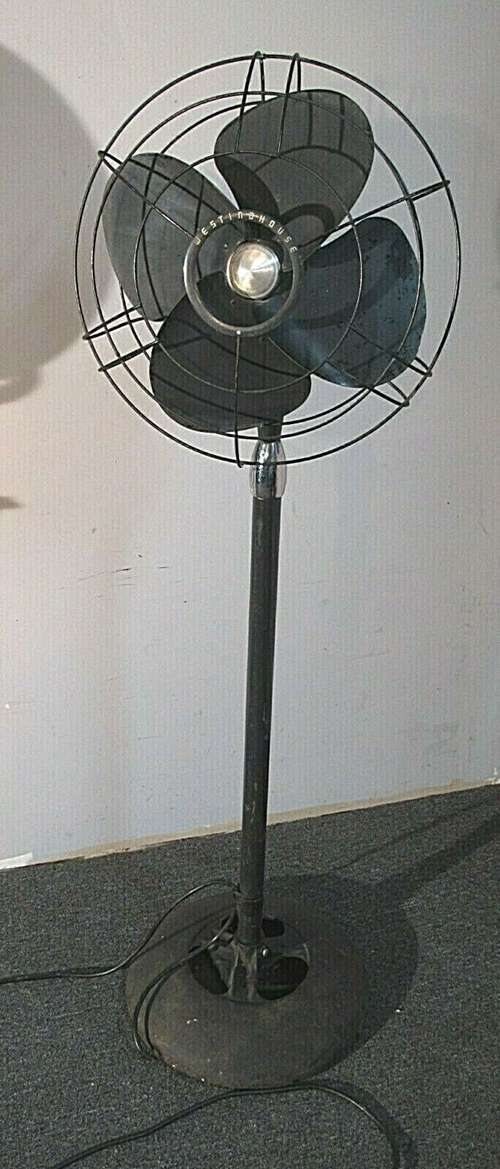
Some key features of the Poweraire include:
- Two-speed function
- Deep-pitched Micarta blade (original)
- Manufactured from the late 1940s to mid-1950s
LivelyAire
The Westinghouse LivelyAire is another vintage fan model, typically found in 10-inch and 12-inch sizes. This fan was first introduced in 1946 as the successor to the Pacemaker model, which was produced from 1937 to 1946. The LivelyAire is known for its streamlined design, making it an attractive choice for collectors.
Features of the LivelyAire include:
- Streamlined design
- 10-inch and 12-inch sizes
- Introduced in 1946
Oscillating
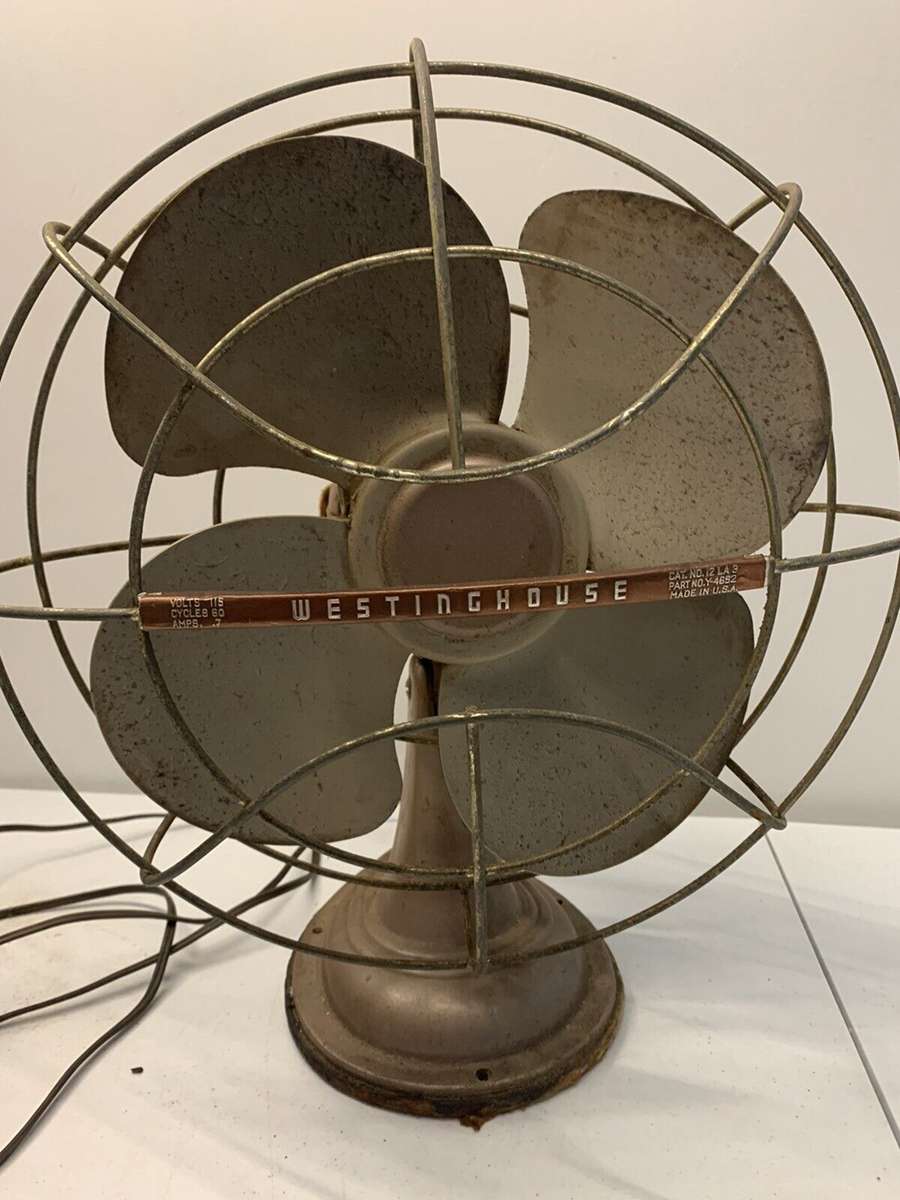
Westinghouse oscillating fans are a vintage category that includes several different models. These fans are characterized by their ability to oscillate, or move from side to side, providing efficient air circulation. One popular oscillating model is the Westinghouse Whirlwind, which runs on a single-speed mechanism and features left-to-right oscillation.
Another oscillating fan worth noting is the Westinghouse Tank. This model can be identified by its brass construction and large “tank-style” oil reservoir in the motor housing used for lubrication. These fans were produced in the early 1900s, making them true antique pieces for collectors.
Here’s a brief overview of some oscillating Westinghouse fans:
- Westinghouse Whirlwind
- Single-speed mechanism
- Left-to-right oscillation
- Westinghouse Tank
- Brass construction
- Tank-style oil reservoir for lubrication
- Produced in the early 1900s
Now that you’re familiar with some popular Westinghouse vintage fans, including Poweraire, LivelyAire, and oscillating models, you can continue your search for the perfect addition to your collection or showcase them if you already own one.
Identifying Westinghouse Fan Features
In this section, we’ll discuss some key features that will help you identify and differentiate between various Westinghouse fan models.
Cage
The cage of a vintage Westinghouse fan typically consists of wire or metal bars that protect the blades. Look for the following characteristics in the cage:
- Material: Most cages are made of brass or steel.
- Size: Some cages are larger and more ornate, while others are simpler and smaller.
- Shape: Pay attention to the shape of the cage (circular, square, or other geometric patterns.)
Blades
Now let’s talk about the blades of Westinghouse fans:
- Material: Brass or steel blades are common, but some models may have unique materials like Micarta, a lightweight plastic-type material.
- Size: Westinghouse fans come in various sizes, ranging from 6 inches to 16 inches.
- Style: Some fans have broad, flat blades, while others have more narrow, curved blades.
Motor Tag
The motor tag contains important information that can aid in the identification of your Westinghouse fan:
- Model number: This number can help you determine the specific fan type and production year range.
- Serial number: Unique to each fan, the serial number can sometimes narrow down the production year or provide additional information about the fan’s origin.
- Voltage, amperage, and other electrical specifications: These details may vary between different models and can provide insight into the fan’s functionality.
Switches
Finally, take note of the switches on the Westinghouse fan, which may differ between models:
- Location: Some switches are mounted on the base, others on the motor housing, and sometimes even on the cage.
- Type: Vintage Westinghouse fans can have toggle, slide, or rotary switches.
- Speed settings: Single-speed, two-speed, and multi-speed options can be found in these fans, depending on the model.
By examining the cage, blades, motor tag, and switches, you should be able to successfully identify the specific model of your vintage Westinghouse fan. Happy hunting!
Popular Models and Collectible Options
In your quest for collectible Westinghouse fans, there are several popular models to explore. Knowing the appeal of these models will help you identify the most desirable options, increase your appreciation of classic fans, and, if you’re looking to sell, setting an informed price.
Among these popular models, consider looking for the 1950’s Westinghouse Electric Fan. This fan offers a mix of form and functionality, featuring an Art Deco design and a striking ‘shadow green’ color, typical of the era. The model has an oscillating feature, as well as a single speed for straightforward use. Keep this classic design in mind as you expand your collection.
Another noteworthy option is the Westinghouse PowerAire Fan. Produced in the 1940s, this particular model can be found in various sizes, like 12″ (Model No. 12PA2) and 16″ versions. This functional fan has three different speed settings, allowing for customizable use while maintaining a vintage appeal. The PowerAire fans are valuable collectibles, with excellent preservation adding to their allure.
Some of the rarer finds among Westinghouse fans include the early “Darth Vader” model from the mid-1930s to early 1940s. With a distinctive metallic finish and modern feel for its time, this model has gained desirability among fan collectors. As with any collectible, scarcity increases value, and finding a fully-working “Darth Vader” model in good condition can be quite rewarding.
Lastly, don’t overlook the Westinghouse Master-Aire series from the early 1930s, which showcases unique design elements such as micarta blades instead of traditional metal. Available in a range of sizes, these models feature the elegance and detail that vintage fan enthusiasts adore.
When examining potential additions to your collection, be mindful of these factors:
- Condition: Working condition and minimal damage to the fan is ideal.
- Rarity: The scarcity of a model influences demand and price.
- Design: Unique or stylish designs, like Art Deco, adds value.
By staying informed about popular models and desirable options, you’ll enhance your vintage Westinghouse fan collection and make informed decisions about their value and potential demand. Happy collecting!
Estimating Value and Price Guide
When estimating the value of your vintage Westinghouse fan, it’s important to consider factors such as type, age, and size. The condition of the fan and its rarity also play a significant role in determining its value.
To begin, you should first identify the type of Westinghouse fan you have. This can be done by examining the fan for any markings or model numbers, which can often be found on a label, sticker, or metal plate. Some common types of Westinghouse fans include the Architectural Fan, Debon-Air Model 46, Master-Aire Model 12-F-3, and the Whirlwind.
Once you have identified your fan, you can start determining its age. Vintage Westinghouse fans generally date back to the 1930s and 1940s, with some models even dating back to the 1920s. Look for any manufacturing dates listed on the fan or consult an expert in antique fans to estimate the age based on design and materials used.
Knowing the size of your fan is vital when pricing it. Westinghouse fans came in various sizes, typically ranging from 6 inches to 16 inches in diameter. Measure the diameter of the fan’s blades or consult the model number’s specifications to determine its size.
With the type, age, and size identified, you can begin to estimate the value of your fan. Prices for vintage Westinghouse fans vary, with some models fetching as little as $50, while others can reach prices closer to $400. The value is determined by the individual fan’s rarity, condition, and overall desirability in the market.
For a rough estimate, consider these price ranges for different types of Westinghouse fans:
- Architectural Fan (circa 1930): $100-$200
- Debon-Air Model 46 (1931): $80-$160
- Master-Aire Model 12-F-3 (1934): $150-$300
- Whirlwind: $50-$150
Note that these prices are only an approximate guide, and the actual value of your fan may be higher or lower. It’s essential to consult reputable resources, such as collector forums and antique fan dealers, to get the most accurate estimate of your fan’s value.
Remember that the condition of your fan plays a significant role in determining its value. A well-maintained, fully functional fan will fetch a higher price than one that’s visibly worn or non-operational. If you’re seeking to sell your vintage Westinghouse fan, taking the time to clean and restore it may increase its value and appeal to potential buyers.
In summary, estimating the value of your vintage Westinghouse fan will involve identifying its type, age, and size, along with assessing its condition and market demand. By taking these factors into consideration, you can gain an accurate understanding of your fan’s value and price it accordingly.
10 Factors to Identify & Value Vintage Westinghouse Fan
1. Age
Vintage Westinghouse fans are sought after by collectors for their distinctive designs and historical significance. Their values are greatly influenced by the age of the fan. Knowing the approximate production date can help you determine the rarity and value of your fan.
In general, older Westinghouse fans are more sought after and typically have higher values. Here’s a breakdown of some popular models and their average valuations based on age:
| Model & Age | Average Valuation |
|---|---|
| Whirlwind, 1930s-1950s | $70 – $150 |
| Westinghouse Tank, 1909-1913 | $200 – $500 |
| Poweraire, late 1940s-1950s | $100 – $250 |
Some factors that could influence the age of a Westinghouse fan are the presence of a date on the motor tag, the use of a particular blade material (such as the Micarta blade on Poweraire fans), and the specific features of the fan, like the oil reservoir design on Westinghouse Tank fans.
To further narrow down the age of your fan, look for any manufacturing dates, patent numbers, or design features mentioned in the search results provided. For example, the Westinghouse vane oscillator was produced from 1909-1913, making fans from this time period more valuable.
It’s essential to note that the production date alone isn’t the only factor that affects the value of a vintage Westinghouse fan. Other factors include the fan’s condition, the rarity of the model, any unique features it may possess, and the demand in the market at the time of appraisal.
By researching and identifying the age of your Westinghouse fan, you can better understand its historical significance and potential value. This knowledge can help guide your decisions when purchasing, selling, or simply appreciating your collection.
2. Model
When identifying your Vintage Westinghouse Fan, there are different models and their specific features. These models span the late 40’s to the mid 50’s, such as the Pacemaker and the more popular, Poweraire. Knowing the various models and their individual characteristics is crucial in appraising their value.
Pacemaker The Pacemaker was created to compete with the Eskimos and the Zeros during its time period. It was available in 8-inch and 10-inch sizes, with both oscillating and stationary models.
Poweraire The Poweraire 10PA 2 was a 2-speed fan that was more prevalent in the late 40s to mid-50s. It originally had a deep-pitched Micarta blade, a lightweight plastic-type blade. However, some might have a brass blade from the late teens to mid-1920s.
Here’s a table highlighting the average valuation for these Vintage Westinghouse Fan models:
| Model | Average Valuation |
|---|---|
| Pacemaker (8-inch) | $125 – $150 |
| Pacemaker (10-inch) | $150 – $200 |
| Poweraire 10PA 2 | $180 – $250 |
Keep in mind that these valuations are average estimates, and the specific value of your Vintage Westinghouse Fan may vary depending on its condition, rarity, and market demand. It is best to consult with an antique fan collector or specialist to get an accurate appraisal for your specific fan.
3. Material
When it comes to Vintage Westinghouse fans, the materials used in their construction play a significant role in determining their value. As a collector, you should familiarize yourself with the different materials used, their impact on durability, and overall appearance.
Common Materials
- Brass: Frequently used in older Westinghouse fan models, such as the Tank series, this metal signified quality construction and offered a visually appealing appearance. Brass Westinghouse fans generally tend to hold a higher value compared to other materials.
- Steel: Many vintage Westinghouse fans, particularly Poweraire models from the late 1940s to mid-1950s, were made from steel. This material, although durable, might not be as valued as brass but still holds a respectable value in the collector’s market.
- A Bakelite Plastic: This material, which came into use in later models, is less durable and considered less collectible, affecting its overall value. Bakelite plastic was often used in the construction of fan blades, particularly on Poweraire fans with Micarta blades.
Material’s Impact on Value
| Fan Material | Average Valuation |
|---|---|
| Brass | $300 – $400 |
| Steel | $200 – $300 |
| Bakelite Plastic | $100 – $150 |
When evaluating a Vintage Westinghouse fan for your collection, keep in mind the material and its impact on the value. This will help you make well-informed decisions and better appreciate the craftsmanship behind these classic fans. Remember, however, that the value of your Westinghouse fan is also determined by other factors, such as model, condition, and rarity.
4. Speed
When valuing Vintage Westinghouse fans, one major factor to consider is the fan’s speed settings. Typically, these fans come in single, two, or three-speed variations. Throughout the years, Westinghouse has developed different fan models with varying speed options, which can greatly impact their value.
For instance, some fans run on a single-speed mechanism, like the Whirlwind fans. These models often feature left-to-right oscillation and are valued around $70 – $150. In contrast, there are Westinghouse Tank fan models that come in a two-speed variation and are worth more due to their unique speed coil and switches. Other Westinghouse fans may have a three-speed mechanism, making them more versatile and desirable to collectors.
It is important to note that rare or unique speed features can further impact a fan’s value. Some collectors may pay a premium for rare Westinghouse fans with unusual speed settings or unique mechanisms. To help you gauge the value of these fans based on their speed, here is a valuation table:
| Fan Type/Speed Setting | Average Valuation |
|---|---|
| Single-Speed Whirlwind | $70 – $150 |
| Two-Speed Tank | Based on rarity/condition |
| Three-Speed Models | Based on rarity/condition |
Keep in mind that these values are approximate and can vary depending on other factors such as condition, rarity, and market demand. Combining the information on speed with other aspects of a vintage fan, such as its design, materials, and era, can help you make a more accurate assessment of its worth. As a collector, understanding the relationship between speed settings and values will better prepare you for making informed decisions when purchasing Vintage Westinghouse fans.
5. Color
When it comes to Vintage Westinghouse Fans, color plays a significant role in determining their value. Collectors appreciate rare and unique colors that can add visual appeal and diversity to their collection. In this section, you’ll learn about some common color variations and the impact they have on the valuation of these vintage fans.
Vintage Westinghouse Fans come in a variety of colors, ranging from classic black and bold white to more specific hues, such as Riviera Gray from the 1940s. The presence and condition of the original paintwork can significantly influence the fan’s value; well-preserved, original finishes are more desirable than repainted or damaged finishes.
The following table shows some Vintage Westinghouse Fan color variations and their average valuation:
| Vintage Westinghouse Fan Color | Average Valuation |
|---|---|
| Classic Black | $100 – $150 |
| Bold White | $90 – $130 |
| Riviera Gray (1940s) | $150 – $200 |
| Blue | $80 – $120 |
| Green | $70 – $100 |
| Other Unique Colors | $150 – $250 |
While the color itself is an essential factor in the valuation, the fan’s overall condition, rarity, and model type are also important aspects to consider. A fan with an unusual color but in poor condition may be less valuable than a fan in excellent condition with a more common color.
Keep in mind that it is essential to ensure that the color is original and not a result of repainting to achieve maximum value. Additionally, be aware of any potential damage or fading due to exposure to sunlight or other environmental factors, which can also affect the fan’s worth.
6. Size
When identifying and evaluating vintage Westinghouse fans, size plays a significant role in the overall appraisal. Larger fans generally attract higher valuations due to their rarity and increased functionality, while smaller desk fans may be more affordable to the general collector.
In order to provide a better understanding of how size may impact the value of a vintage Westinghouse fan, the following table lists common sizes and their average valuation:
| Size (Blade Diameter) | Average Valuation |
|---|---|
| 6 inches | $50 – $100 |
| 9 inches | $70 – $150 |
| 12 inches | $100 – $250 |
| 16 inches | $200 – $400 |
Please note that these valuations are an approximation and can vary depending on factors such as condition, age, rarity, and demand for a specific model.
When considering a fan’s size, it’s also important to take note of the fan’s motor size and functionality. For example, Westinghouse’s Tank fan features a powerful motor, large oil reservoir, and brass construction. This results in increased demand among collectors and may contribute to a higher valuation for a larger Tank fan. However, this doesn’t mean that smaller fans of other models won’t hold value; they may have their own distinctive characteristics that can make them desirable to collectors.
In summary, the size of a vintage Westinghouse fan can have a noticeable impact on its value. Larger fans, especially those with additional unique features or in exceptional condition, may command higher valuations. Evaluating fans based on their size and unique characteristics will help you make informed decisions when adding pieces to your collection.
7. Completeness
When evaluating the value and appraisal of Vintage Westinghouse Fans, the completeness factor plays a significant role. The more complete and well preserved a fan is, the higher its value.
Fans with all their original parts, such as blades, motor, cage, and base, in working condition tend to have higher valuations. Moreover, fans with unique or rare characteristics will also affect their valuation. In the case of Westinghouse fans, there are some specific models and styles that are particularly sought after by collectors.
Here is a valuation table taking into account the completeness factor:
| Westinghouse Fan Model | Average Valuation |
|---|---|
| Whirlwind, complete and working | $70 – $150 |
| Tank, complete and working | $200 – $400 |
| Vane Oscillator, complete and working | $300 – $500 |
| Poweraire, with original Micarta blade | $150 – $250 |
Additionally, the presence of original paint, decals, and badges can also add value to your fan. Keep in mind that any repairs or restorations done on the fan should maintain its authenticity, as modifications using non-original parts can detract from the value.
Taking care of your Vintage Westinghouse Fan is crucial, especially if you are planning to resell it, as a well-preserved fan can garner higher appraisals and increase its demand among collectors. So, ensure that your fan is maintained regularly, with proper lubrication and cleaning to keep it in its best condition.
Final Thoughts
As you explore the world of vintage Westinghouse fans, it’s crucial to familiarize yourself with various types and models available. You can do this by conducting thorough research and understanding their differences in design, functionality, and age.
When determining the value of these fans, consider factors like rarity, condition, and any unique features that set them apart from other models. Keep in mind that some vintage Westinghouse fans might be more valuable than others, so it’s essential to compare your findings with similar items sold in the market.
As you embark on the journey to collect vintage Westinghouse fans, it’s essential to have a keen eye for the following:
- Identify the specific model and manufacturing date of the fan you’re interested in
- Understand the varying values of different models and what might contribute to their worth
- Inspect the condition of the fan and identify any necessary repairs or restorations needed
- Approach your restoration or repair projects with caution and seek expert help when needed
Make sure to approach your vintage Westinghouse fan collection with patience, passion, and diligence. In doing so, you’ll likely uncover fascinating pieces of history and increase your appreciation for the craftsmanship and engineering of these classic fans. Happy collecting!
FAQ
How can I identify a vintage Westinghouse fan?
To identify a vintage Westinghouse fan, you can look for specific features that were common in their older models. For example, Whirlwind fans typically run on a single-speed mechanism and have left-to-right oscillation. Westinghouse Tank fans can be recognized by their brass construction and a large “tank-style” oil reservoir in the motor housing for lubrication.
What is the value of a vintage Westinghouse fan?
The value of a vintage Westinghouse fan varies depending on the model, condition, and rarity. Generally, Whirlwind fans can cost around $70 – $150. However, it’s essential to research your specific fan model and consult antique fan collectors or experts for more accurate valuations.
How do I determine the age of my vintage Westinghouse fan?
You can determine the age of your vintage Westinghouse fan by looking for specific markings or serial numbers on the fan’s housing, motor, or other components. It may also be helpful to consult online resources, such as antique fan forums, to compare your fan’s features with those of known models dating from certain time periods.
Is it safe to use a vintage Westinghouse fan?
While vintage Westinghouse fans are often still functional, it’s important to consider their age and the possibility of worn or outdated electrical components. If you plan to use your vintage fan, consult an electrician or appliance technician to inspect and make any necessary updates or repairs to ensure the fan’s safe operation.
How do I maintain my vintage Westinghouse fan?
Proper maintenance of your vintage Westinghouse fan includes regular cleaning, lubrication, and checking for any wear and tear on components. Some fans may require occasional oiling for smooth operation, while others may benefit from tightening screws, replacing worn parts, or attending to electrical connections. Be sure to consult your fan’s specific manual, if available, or online resources for best maintenance practices.


